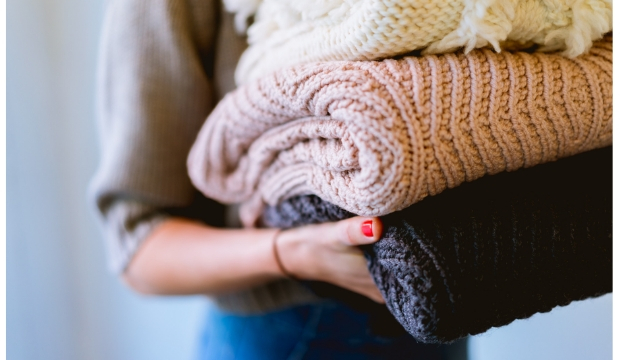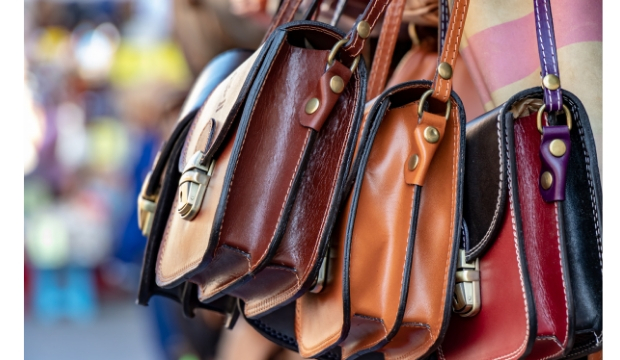Prevent moth holes, clean and store cashmere
Wardrobe hacks, moth-proof storage solutions and laundry tips to make your clothes last

The reality of investing in a designer wardrobe is that the initial outlay is just the beginning. High-end brands tend to favour natural fabrics such as wool, silk and cashmere, which are unfortunately exactly the materials on which clothes moths (or more specifically clothes moth eggs and larvae) love to feast. Imagine a moth larva as the clothes-loving cousin of The Very Hungry Caterpillar – it sees your wardrobe as an all-you-can-eat buffet, feasting on your beloved Chanel wool jacket, Celine silk shirt and Bella Freud sweater without a qualm.

Lauren Fleischmann, Unsplash
As the seasons change those of us for whom space is at a premium will start to think about switching the clothes in our wardrobes from winter to summer. And while right now you may be sick of the sight of the woollies that have kept you warm all winter, it will pay to take the time to properly store your clothing to protect it from moths and prevent damage to fibres and fabrics.
Read on for our guide to how to store woollens, prevent moth holes, and kill moths, eggs and larvae.
Cleanliness is key to moth prevention

Yasmine Boheas, Unsplash
Even if clothes look clean they often have invisible stains from food and drink, and perspiration, while skin and hair can cling to fabrics, all of which moth eggs love to feast on. Regularly laundering your clothing will ensure that these stains don't build up which, as well as attracting moths would also cause long-term damage, stains and smells.
Dry cleaning is a good option for a pre-storage deep-clean as the moths don't like the smell of the solvents, but gently hand-washing knitwear is another good option, as is using the woollen or delicate setting on your washing machine. Ensure that it's on a cold-water, low-spin cycle and that you use a suitably gentle detergent or shampoo.
Once washed, roll the garment in a clean towel and gently press out as much water as possible before drying flat (the weight of the moisture will warp the fibres if left to drip dry), ensuring each item is completely dry before putting it away to avoid any musty smells. If hand-washing hasn't gone well for you in the past you'll find that most dry cleaners offer this service too.
Items that can't be laundered should be taken outside on a dry sunny day and brushed down briskly but carefully to remove hair, sweat and skin cells as well as eggs or larvae. Work across the inside and outside of the garment and pay close attention to seams, necklines, pleats, pockets and the inner armpit areas.
Another alternative is to freeze clothing in a sealed plastic bag for up to two weeks to try to kill off the culprits. Frozen items need to come up to room temperature gradually, within the bag in which they were frozen and should still be cleaned in order to store them with other items.
Clothes which are made of synthetic materials can be laundered according to the instructions on the label, but do ensure they're clean – as although moths rarely eat synthetic fibres they are attracted to stains and dirt anywhere and everywhere.
How to store your winter clothes

Micheile Henderson, Unsplash
Wrap each item in a clean cotton pillowcase, length of cotton sheeting or acid-free tissue to create a further barrier from pests, then pack into a clean container – plastic is good but some fibres need something more breathable. Check that the container is clean by vacuuming and wiping down with a damp, detergent-soaked cloth to ensure all dust, hair and any eggs or moth larvae are removed if you can.
Nestle lavender sachets, cedarwood blocks or Rentokil moth papers inside the box to help ward off egg-laying adult moths, but remember these don't last forever and need to be regularly replaced or renewed. Tape up any edges, zips or openings of your containers.
Rather than using one big storage box, spread the items over a few boxes or storage bags, and for ease of unpacking compile an inventory of what's in each box which you should tape to its side. Vacuum-pack bags are good for bulky and robust items like bedding, but can crush and crease delicates like silk while the completely airtight environment isn't a great long-term home for woollens either.
Store your cleaned, properly packed clothes away from carpets and other fabrics and soft furnishings, ideally somewhere clean and cool as moths prefer the warmth of modern homes. As well as keeping your clothes clean it's important to keep carpets, soft furnishings and even curtains clean and free from dust to ensure that hungry moths find little to eat.
Know your enemy

Tu Tu, Unsplash
Worried about that big moth fluttering about your bedroom? Annoying as it might be, it's not to blame for damaging your wardrobe. Your favourite vintage jacket, however, may be the culprit. Vintage, used or second-hand clothing should be thoroughly treated as above before it's introduced into your wardrobe.
There are only a few types of moths to worry about when it comes to protecting your clothes, one of which is Tinea pellionella, more commonly known as the case-bearing carpet moth.
All clothes moths are tiny and rarely seen by the naked eye. Adult moths don't actually damage clothes, it is the eggs they lay – and the larvae these subsequently grow into – that do. If you do spot a clothes moth, chances are the eggs are already laid but there might be time to prevent further damage being done.
If you suspect a clothes-moth infestation, take all your clothes out of your wardrobe and either machine-wash, hand-wash or dry-clean them following the steps above. Vacuum and wipe every corner of your wardrobe, chest of drawers and closet before replacing your laundered clothes.
Pheromone traps won't help prevent moths but are a good indication of whether the moths have come back and the level of infestation, as male moths will get stuck to these.
Protect bags and shoes too

Alfonso Ramirez, Unsplash
Silk, leather, feather and shearling elements of accessories are all fodder for clothes-moth eggs, so regularly wipe shoes with a soft cloth (inside and out) to remove dust and consider storing them in shoe boxes with lavender sachets.
Wipe handbags down with a soft cloth and brush or vacuum the lining – paying close attention to the seams and pockets. The dust bag your designer shoes or handbag came with should be kept clean and brushed (outside) regularly for dust, eggs and larvae.
Make a date
Eric Rothermel, Unsplash
Lavender sachets, cedarwood blocks, Rentokil Clothes Moth Killer Cassettes and pheromone traps all have a part to play in the war against moths and should be deployed in your wardrobe throughout the year as well as when packing away your clothes.
These need to be replaced regularly – usually every six to 12 weeks – so make a note in your diary for when they need changing, and scribble on each the date it was added with a permanent marker (make sure it won't stain any clothing when you position it).
Clothes moths don't survive well in items which are well looked after and regularly worn and exposed to light and movement so one of the best things you can do is keep your clothing to a minimum and ensure that you wear all of it – meaning it's the perfect excuse to KonMari your wardrobe. Just be sure to clean everything well before putting it back in your wardrobe.
All is not lost
Annoying as it might be, a motheaten sweater needn't be sent straight for recycling, instead turn to one of London's talented repair services that might be able to mend it invisibly or even make a feature out of it.






